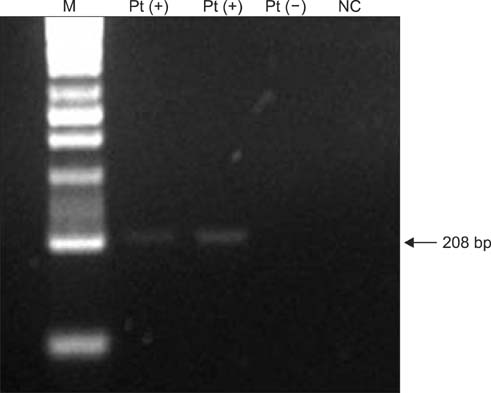Korean J Urol.
2011 Mar;52(3):194-199.
Detection of Nanobacteria in Patients with Chronic Prostatitis and Vaginitis by Reverse Transcriptase Polymerase Chain Reaction
- Affiliations
-
- 1Department of Urology, Chung-Ang University College of Medicine, Seoul, Korea.
- 2Department of Laboratory Medicine, Chung-Ang University College of Medicine, Seoul, Korea. hyekim@cau.ac.kr
Abstract
- PURPOSE
We aimed to investigate the detection of nanobacteria (NB) from expressed prostatic secretions (EPS) in patients with category III chronic prostatitis/chronic pelvic pain syndrome (CP/CPPS) and from vaginal swabs in patients with vaginitis by reverse transcriptase polymerase chain reaction (RT-PCR) and to evaluate the association between NB and Neisseria gonorrhea, Chlamydia trachomatis, Ureaplasma urealyticum (U. urealyticum), Mycoplasma hominis, Trichomonas vaginalis, and Mycoplasma genitalium.
MATERIALS AND METHODS
A group of 11 men attending a specialized CP/CPPS clinic and a group of 157 women who reported symptoms of lower genital tract infection were enrolled in this study. NB were detected by RT-PCR. A Seeplex Sexually Transmitted Disease Detection assay (Seegene Inc., Seoul, Korea) was used that could detect DNA for 6 types of sexually transmitted pathogens.
RESULTS
In EPS samples, the detection rate of NB in patients with CP/CPPS was 9.1%, and 9 (5.7%) of 157 vaginitis patients showed positive results in RT-PCR for NB in vaginal swabs. Associations observed among the 7 microorganisms included 6 (54.5%) patients who tested positive on EPS and 75 (47.8%) patients who tested positive on vaginal swabs. Five patients with vaginitis were found to have monoinfection of NB (6.7%).
CONCLUSIONS
We found that conventional RT-PCR for NB was rapid, simple, low in cost, and easily available for the detection of NB, and that NB may be a possible etiological factor for vaginitis and CP/CPPS. The prevalence of U. urealyticum among the four patients with NB coinfection was 75%; the presence of U. urealyticum might therefore raise suspicion for nanobacterial infection.
MeSH Terms
-
Calcifying Nanoparticles
Chlamydia trachomatis
Coinfection
DNA
Female
Gonorrhea
Humans
Male
Mycoplasma
Mycoplasma hominis
Nanoparticles
Neisseria
Pelvic Pain
Prevalence
Prostatitis
Reproductive Tract Infections
Reverse Transcriptase Polymerase Chain Reaction
RNA-Directed DNA Polymerase
Sexually Transmitted Diseases
Trichomonas vaginalis
Ureaplasma urealyticum
Vaginitis
Calcifying Nanoparticles
DNA
RNA-Directed DNA Polymerase
Figure
Reference
-
1. Millán-Rodríguez F, Palou J, Bujons-Tur A, Musquera-Felip M, Sevilla-Cecilia C, Serrallach-Orejas M, et al. Acute bacterial prostatitis: two different sub-categories according to a previous manipulation of the lower urinary tract. World J Urol. 2006. 24:45–50.2. Wood HM, Shoskes DA. The role of nanobacteria in urologic disease. World J Urol. 2006. 24:51–54.3. Fortenberry JD, Brizendine EJ, Katz BP, Wools KK, Blythe MJ, Orr DP. Subsequent sexually transmitted infections among adolescent women with genital infection due to Chlamydia trachomatis, Neisseria gonorrhoeae, or Trichomonas vaginalis. Sex Transm Dis. 1999. 26:26–32.4. Bratos-Pérez MA, Sánchez PL, García de Cruz S, Villacorta E, Palacios IF, Fernández-Fernández JM, et al. Association between self-replicating calcifying nanoparticles and aortic stenosis: a possible link to valve calcification. Eur Heart J. 2008. 29:371–376.5. Ciftçioglu N, Björklund M, Kuorikoski K, Bergström K, Kajander EO. Nanobacteria: an infectious cause for kidney stone formation. Kidney Int. 1999. 56:1893–1898.6. Kajander EO, Ciftçioglu N. Nanobacteria: an alternative mechanism for pathogenic intra- and extracellular calcification and stone formation. Proc Natl Acad Sci U S A. 1998. 95:8274–8279.7. Zhou Z, Hong L, Shen X, Rao X, Jin X, Lu G, et al. Detection of nanobacteria infection in type III prostatitis. Urology. 2008. 71:1091–1095.8. Hudelist G, Singer CF, Kubista E, Manavi M, Mueller R, Pischinger K, et al. Presence of nanobacteria in psammoma bodies of ovarian cancer: evidence for pathogenetic role in intratumoral biomineralization. Histopathology. 2004. 45:633–637.9. Litwin MS, McNaughton-Collins M, Fowler FJ Jr, Nickel JC, Calhoun EA, Pontari MA, et al. The National Institutes of Health chronic prostatitis symptom index: development and validation of a new outcome measure. Chronic Prostatitis Collaborative Research Network. J Urol. 1999. 162:369–375.10. Miller VM, Rodgers G, Charlesworth JA, Kirkland B, Severson SR, Rasmussen TE, et al. Evidence of nanobacterial-like structures in calcified human arteries and cardiac valves. Am J Physiol Heart Circ Physiol. 2004. 287:H1115–H1124.11. Raoult D, Drancourt M, Azza S, Nappez C, Guieu R, Rolain JM, et al. Nanobacteria are mineralo fetuin complexes. PLoS Pathog. 2008. 4:e41.12. Young JD, Martel J, Young D, Young A, Hung CM, Young L, et al. Characterization of granulations of calcium and apatite in serum as pleomorphic mineralo-protein complexes and as precursors of putative nanobacteria. PLoS One. 2009. 4:e5421.13. Ciftçioğlu N, McKay DS, Kajander EO. Association between nanobacteria and periodontal disease. Circulation. 2003. 108:e58–e59.14. Zhang QH, Shen XC, Zhou ZS, Chen ZW, Lu GS, Song B. Decreased nanobacteria levels and symptoms of nanobacteria- associated interstitial cystitis/painful bladder syndrome after tetracycline treatment. Int Urogynecol J Pelvic Floor Dysfunct. 2010. 21:103–109.15. Shoskes DA, Thomas KD, Gomez E. Anti-nanobacterial therapy for men with chronic prostatitis/chronic pelvic pain syndrome and prostatic stones: preliminary experience. J Urol. 2005. 173:474–477.16. Shen X, Ming A, Li X, Zhou Z, Song B. Nanobacteria: a possible etiology for type III prostatitis. J Urol. 2010. 184:364–369.17. Soper D. Trichomoniasis: under control or undercontrolled? Am J Obstet Gynecol. 2004. 190:281–290.18. Pararas MV, Skevaki CL, Kafetzis DA. Preterm birth due to maternal infection: causative pathogens and modes of prevention. Eur J Clin Microbiol Infect Dis. 2006. 25:562–569.
- Full Text Links
- Actions
-
Cited
- CITED
-
- Close
- Share
- Similar articles
-
- The detection of circulating breast cancer cells in peripheral blood by reverse transcriptase-polymerase chain reaction
- The Diagnostic Values of the Polymerase Chain Reaction in Prostatitis
- Detection of Micrometastasis in Draining Vein before & after Manipulation and Peritoneal Cavity in Colorectal Cancer by Reverse Transcriptase-Polymerase Chain Reactions for Cytokeratin 20 and Carcinoembryonic Antigen
- Development of Multiplex Reverse Transcription Polymerase Chain Reaction for Detection and Typing of Parainfluenza Viruses
- Interleukin-1beta, Tumor Necrosis Factor-alpha, Transforming Growth Factor-beta Expression in Fetal Blood Detected by Reverse Transcriptase-Polymerase Chain Reaction


